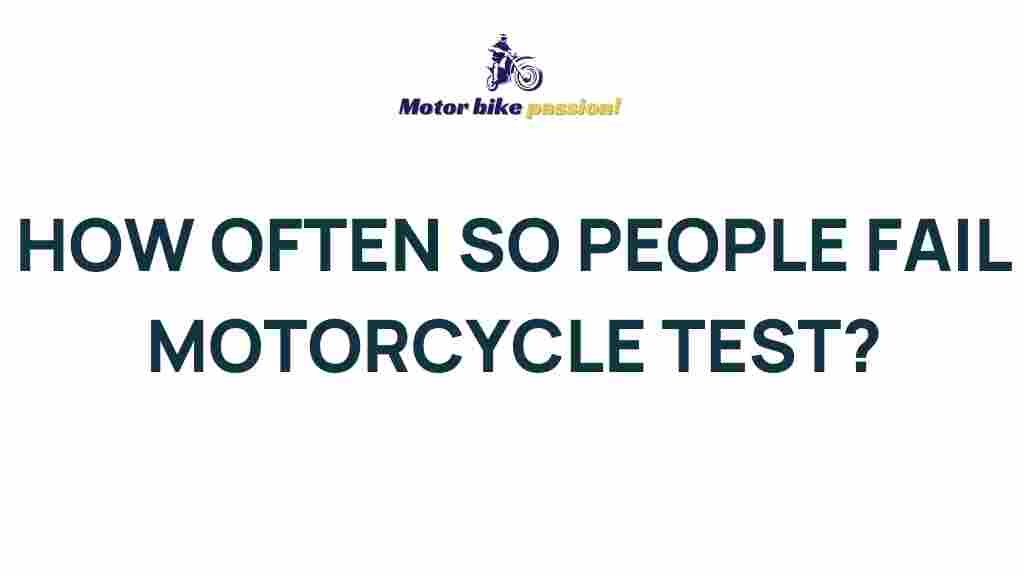Unveiling the Surprising Reasons Behind Motorcycle Test Failures
Obtaining a motorcycle license is an exciting milestone for many riders. However, the journey to successfully passing your motorcycle test can be fraught with challenges. Understanding the failure reasons behind motorcycle test failures is crucial for aspiring riders. This article delves into common mistakes made during the motorcycle test, offers passing tips, and provides essential advice for thorough test preparation.
Understanding the Motorcycle Test
The motorcycle test is designed to evaluate a rider’s ability to operate a motorcycle safely and competently. Typically, the test consists of two parts: the written knowledge test and the practical riding test. Each of these components assesses different skills and knowledge that are vital for safe riding.
Common Reasons for Motorcycle Test Failures
Despite rigorous preparation, many riders still fail their motorcycle tests. Here are some of the most common reasons for failure:
- Improper Use of Controls: Failing to demonstrate proper use of brakes, throttle, and clutch can lead to immediate failure.
- Inadequate Observation: Not checking mirrors or blind spots can result in dangerous situations and a failed test.
- Poor Cornering Techniques: Incorrect body positioning and throttle control during turns can lead to loss of control.
- Failure to Follow Instructions: Ignoring examiner instructions during the test can be detrimental.
- Unsafe Driving Practices: Speeding, weaving, or driving too close to other vehicles can result in a failure.
Common Mistakes During the Motorcycle Test
Many riders make simple yet critical mistakes that contribute to their test failures. Here are a few common mistakes to avoid:
- Not Practicing Enough: Insufficient practice can lead to a lack of confidence and poor performance.
- Neglecting Pre-Ride Checks: Failing to perform a basic safety check of the motorcycle can lead to avoidable issues.
- Overlooking Road Signs: Ignoring road signs or signals during the test can lead to confusion and errors.
- Inconsistent Speed: Riding too fast or too slow can be perceived as a lack of control.
- Not Wearing Proper Gear: Riding without appropriate safety gear can affect both safety and test results.
Essential Tips for Passing the Motorcycle Test
To increase your chances of passing the motorcycle test, consider the following tips:
- Take a Motorcycle Safety Course: Enrolling in a safety course can provide valuable skills and knowledge.
- Practice Regularly: Consistent practice will help you become more comfortable operating your motorcycle.
- Know the Test Route: Familiarizing yourself with the test route can help you anticipate challenges.
- Stay Calm and Focused: Maintaining composure during the test is crucial for clear decision-making.
- Prepare Mentally: Visualize yourself passing the test to build confidence.
Test Preparation: A Step-by-Step Process
Effective test preparation is key to success. Here’s a step-by-step process to help you prepare:
Step 1: Understand the Requirements
Familiarize yourself with your local motorcycle test requirements, including age, documentation, and motorcycle specifications.
Step 2: Get the Right Gear
Invest in quality protective gear, including a helmet, gloves, jacket, pants, and boots.
Step 3: Take a Safety Course
Enroll in a recognized motorcycle safety course to learn essential skills and techniques.
Step 4: Practice Riding Skills
Focus on practicing key skills such as steering, braking, shifting, and cornering in a safe environment.
Step 5: Conduct Pre-Ride Checks
Perform a thorough safety check of your motorcycle before each ride.
Step 6: Get Familiar with the Test Format
Understand the structure of the motorcycle test, including both the written and practical components.
Troubleshooting Tips for Common Issues
If you find yourself struggling with certain aspects of the motorcycle test, here are some troubleshooting tips:
- Practice with a Friend: Riding with an experienced friend can provide valuable feedback.
- Record Your Practice Sessions: Videoing your practice can help identify areas for improvement.
- Review Test Materials: Use study guides and practice tests to prepare for the written portion.
- Stay Educated: Continuously learn about motorcycle safety and riding techniques.
Conclusion
Understanding the failure reasons behind motorcycle test failures can significantly enhance your chances of success. By avoiding common mistakes, implementing effective passing tips, and engaging in thorough test preparation, you can confidently approach your motorcycle test. Remember that practice and knowledge are your best allies on the road to obtaining your motorcycle license.
For more information on motorcycle safety and training resources, visit this helpful site. If you need tips on test preparation, check out this resource for additional insights.
This article is in the category Safe Driving and created by MotorBikePassion Team
